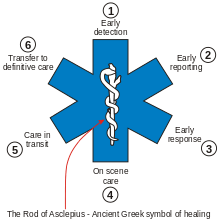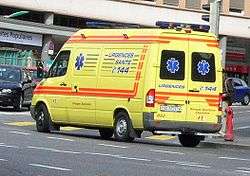Star of Life

The Star of Life is a blue, six-pointed star, outlined[1] with a white border and usually featuring the Rod of Asclepius in the center. The symbol was originally designed and governed by the U.S. National Highway Traffic Safety Administration (NHTSA) under the jurisdiction of the United States Department of Transportation, DOT). It has become a symbol of the emergency medical services in multiple countries.
History
The Star of Life was designed by Leo R. Schwartz, Chief of the EMS Branch, National Highway Traffic Safety Administration (NHTSA) in the United States.[2] Until then, American ambulances had most often used a safety orange cross on a square background. In 1973, the American Red Cross complained that the orange cross too closely resembled their logo of a red cross on a white background; such usage was restricted by the Geneva Conventions.[3]
The newly designed Star of Life was adapted from the Medical Identification Symbol of the American Medical Association,[4] which was trademarked by the American Medical Association (AMA) in 1967. The newly designed logo was trademarked on February 1, 1977 with the Commissioner of Patents and Trade-marks in the name of the National Highway Traffic Safety and Administration (registration number 1058022). The logo was "given" to the National Registry of Emergency Medical Technicians (NREMT) for use as the emergency medical technicians (EMT) logo after the trademark expired in 1997.[5]
Symbolism

The six branches of the star are symbols of the six main tasks executed by rescuers all through the emergency chain:[6]
- Detection: The first rescuers on the scene, usually untrained civilians or those involved in the incident, observe the scene, understand the problem, identify the dangers to themselves and the others, and take appropriate measures to ensure their safety on the scene (environmental, electricity, chemicals, radiation, etc.).
- Reporting: The call for professional help is made and dispatch is connected with the victims, providing emergency medical dispatch.
- Response: The first rescuers provide first aid and immediate care to the extent of their capabilities.
- On scene care: The EMS personnel arrive and provide immediate care to the extent of their capabilities on-scene.
- Care in transit: The EMS personnel proceed to transfer the patient to a hospital via an ambulance or helicopter for specialized care. They provide medical care during the transportation.
- Transfer to definitive care: Appropriate specialized care is provided at the hospital.
Common use

While no agency is tasked solely with enforcing its use as a mark of certification, the Star of Life has traditionally been used as a means of identification for medical personnel, equipment, and vehicles. Many ambulance services mark the symbol on their vehicles, and ambulance crews often wear the design as part of their uniform. It appears on various medical textbooks as well as on a wide range of merchandise aimed at the medic market. In hospitals and other buildings, elevators that are marked with the symbol indicate that the elevator is large enough to hold a stretcher.[7]
See also
References
- ↑ Methodist
- ↑ "The Star of Life". Gorham EMS. Archived from the original on 2007-06-30. Retrieved 2007-06-29.
- ↑ "Star of Life - The EMS Symbol". South Dakota EMS. Archived from the original on 2007-07-11. Retrieved 2007-06-29.
- ↑ Universal Medical Identification Symbol. Am J Dis Child. 1964;107(5):439. doi:10.1001/archpedi.1964.02080060441001
- ↑ "History of National Registry of EMTs". Archived from the original on 2007-06-07. Retrieved 2007-06-29.
- ↑ "Star of Life". Retrieved 2007-06-29.
- ↑ "Articles:Elevator Car Sizes". Hkaconsulting.com. 2011-07-11. Archived from the original on 2011-07-11. Retrieved 2012-09-25.
External links
| Wikimedia Commons has media related to Star of life. |